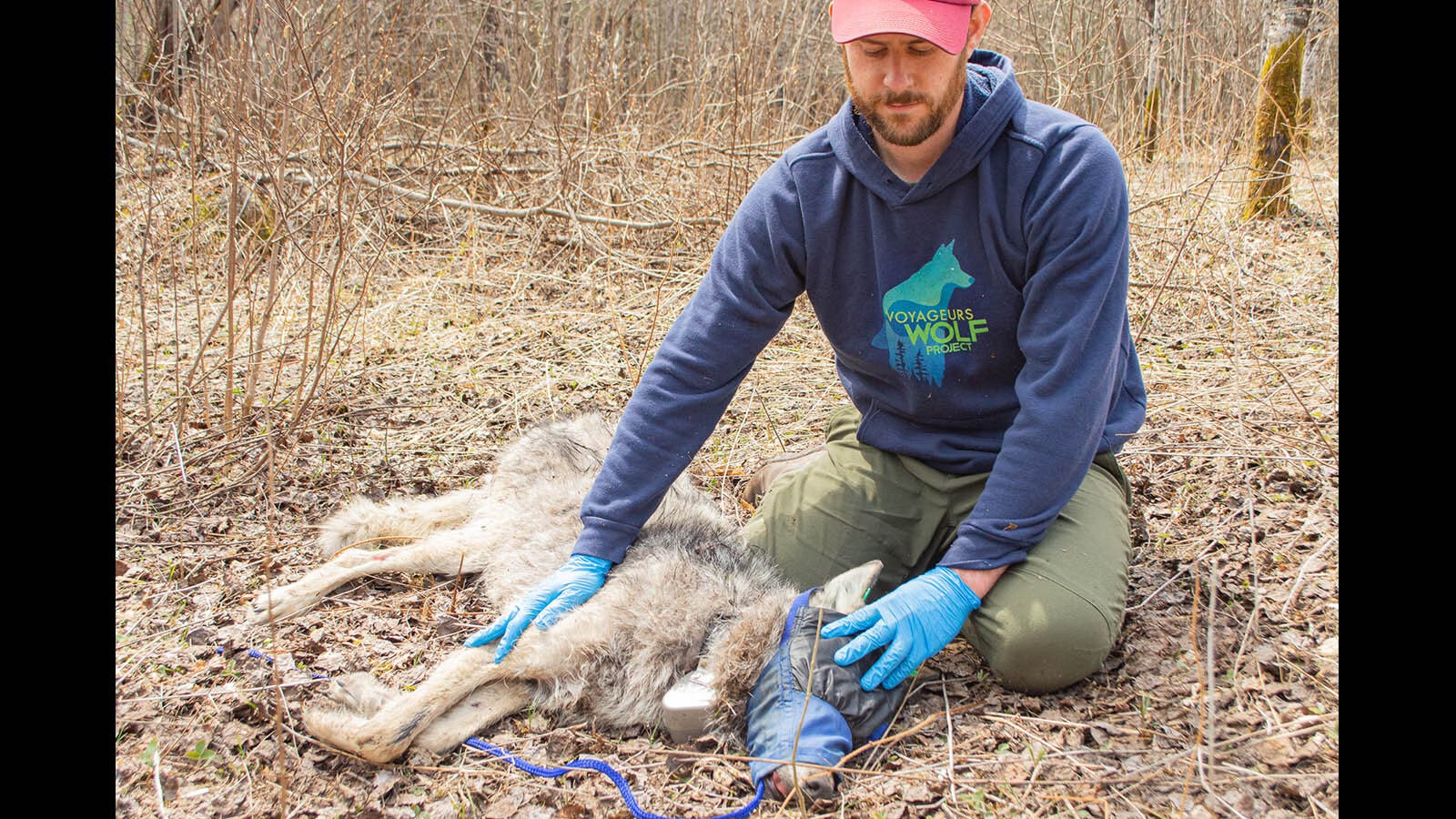A wolf seeking a fresh meal in the humid Minnesota darkness needs sharp ears and patience. Lots of patience.
The wolves “just sit there at night for on the edge of creeks and wait for fish,” wildlife researcher Thomas Gable told Cowboy State Daily. “They’re waiting (for) spawning suckers to come upstream. They hear the suckers break the surface of the water and go in after them.”
That’s right, while wolf packs in Wyoming, Montana and Idaho are going after elk and other big game, their cousins in Minnesota, at least during warmer months, frequently hunt or fish solo, grabbing whatever they can get.
That can include scavenging for anything from wild blueberries to candy from bear hunters’ bait piles, or – if human hunters are successful, bear gut piles, said Gable, who works with the Voyageurs Wolf Project.

A Different Land, A Different Life
About 12 years ago at the start of his career, Gable assisted with wolf research in the Tetons region of Wyoming, so he knows firsthand just how drastically different life is for wolves in the Greater Voyageurs ecosystem than for packs roaming the vast Greater Yellowstone region.
“Wyoming was great, from a research standpoint. You can hike around in the mountains and directly observe the wolves,” he said. “Minnesota is flat with thick, dense forests. You can’t see anything in the summertime. There’s a lot of wetlands and swamps, and in the summer it’s very buggy and humid.”
Researchers there rely heavily on tracking wolves’ movements with radio collars or catching glimpses into their lives through trail camera photos and video footage.
That’s how they surmised that fishing isn’t just a one-off activity for Minnesota wolves, Gable said, but a staple of their diet during the warmer months.
Smaller Area, Smaller Packs, Smaller Wolves
The Greater Voyager ecosystem centers around Voyageurs National Park. The entire ecosystem is roughly 772 square miles, minus significant areas taken up by large lakes. That’s compared to nearly 3,500 square miles in the Greater Yellowstone.
Wolves in Minnesota also run in smaller packs and are physically smaller than wolves in the Rockies.
A “pack” of wolves in Voyageurs can be just two adults and is rarely more than about five, Gable said, whereas packs in Wyoming can be as many as 10 or more.
“Our wolves are smaller, typically between about 57 and 68 pounds for adults,” he said, adding that some wolves in the Rockies have topped 100 pounds.
Wolf numbers are measured differently in Voyageurs too.
“Rather than count individuals, we look at the density of wolves per square mile,” Gable said, adding that’s now estimated to be about 58 wolves per 386 square miles in the core study area.
The entire state of Minnesota is thought to have about 2,700 wolves. The northern Rocky Mountains are home to about 1,700 wolves, including an estimated 314 in Wyoming.
Varying Diet By Season
Minnesota is the only place in the Lower 48 states where wolves were never eradicated, Gable said.
That means the packs in Voyageurs have an unbroken ancestral line – whereas Greater Yellowstone Wolves trace back to those reintroduced into Yellowstone Park in the mid 1990s.
During the winter, the Voyageurs wolves hunt in packs, focusing on abundant whitetail deer.
“We do have some moose, but wolves virtually never kill moose here,” Gable said.
Historically, the Minnesota wolves had abundant caribou to prey upon, but heavy logging in the 19th century wiped the caribou out, he said.
In the summer, adult wolves without pups tend to hunt solo, going after smaller game.
“They aren’t totally by themselves in the summer,” Gable said. “They will come back after hunting to congregate around a den or common spot. But when they go out to hunt, they go out by themselves.”
Beavers are a favorite prey for lone wolves, he said. Wolves have figured out that while beavers have a keen sense of smell, their eyesight is terrible.
“They will sit absolutely still around beaver ponds, downwind from places where beavers might come onto land and they wait there, sometimes for 12 hours at a time,” Gable said.
And when the pickings get sparse toward the end of summer, wolves will take to eating wild blueberries.
“The blueberries become abundant during the late summer. Wolves will start mowing down on blueberries extensively. It’s probably starvation food, that slows down their weight loss,” Gable said.
Territorial Disputes
Just like wolves in Wyoming, Minnesota packs respect each other’s territories. There will be some overlap in packs’ borders, but wolves are extremely cautious about crossing lines, he said.
Wolves in Wyoming have been known to kill each other over territorial disputes, Wyoming Game and Fish Department large carnivore specialist Dan Thompson recently told Cowboy State Daily.
The same sometimes happens in Minnesota, particularly during the breeding season in January, Gable said.
Most recently, a pack that consisted of a breeding pair and one of their grown offspring was eliminated by rivals, he said. The two older wolves were killed on separate occasions. The fate of the third is uncertain.
“That ended that pack, just like that,” he said.
Loves His Job
While he remembers his time in Wyoming fondly and is still fascinated by the Yellowstone wolves, Gable said he probably won’t return to the Cowboy State anytime soon.
“I love working in Minnesota. I’m just fascinated by the ecosystem here,” he said. “I really enjoyed my time in Wyoming, but I’m totally happy where I’m at now.”





